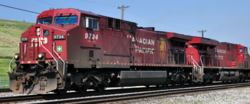Canadian Pacific Railway
 |
|

Canadian Pacific system map (does not include DM&E trackage)
|
|
 |
|
| Reporting mark | CP |
|---|---|
| Locale | Canada with branches to 5 United States cities: Chicago, Detroit, Milwaukee, Minneapolis and New York City |
| Dates of operation | February 16, 1881–present |
| Track gauge | 1,435 mm (4 ft 8 1⁄2 in) standard gauge |
| Website | www |
 |
|
| Public | |
| Traded as | : CP : CP |
| Industry | Rail transport |
| Founded | February 16, 1881 |
| Headquarters | Calgary, Alberta, Canada |
|
Area served
|
Canada Contiguous United States |
|
Key people
|
Andrew Reardon (Chairman) E. Hunter Harrison (CEO) Keith Creel (President and COO) |
| Revenue |
|
|
|
|
|
|
|
| Total assets |
|
| Total equity |
|
| Website | www |
The Canadian Pacific Railway (CPR), also known formerly as CP Rail (reporting mark CP) between 1968 and 1996, is a historic Canadian Class I railroad incorporated in 1881. The railroad is owned by Canadian Pacific Railway Limited, which began operations as legal owner in a corporate restructuring in 2001.
Headquartered in Calgary, Alberta, it owns approximately 20,000 kilometres (12,500 mi) of track all across Canada and into the United States, stretching from Montreal to Vancouver, and as far north as Edmonton. Its rail network also serves five major cities in the United States, such as Minneapolis, Milwaukee, Detroit, Chicago, and New York City.
The railway was originally built between Eastern Canada and British Columbia between 1881 and 1885 (connecting with Ottawa Valley and Georgian Bay area lines built earlier), fulfilling a promise extended to British Columbia when it entered Confederation in 1871. It was Canada's first transcontinental railway, but currently does not reach the Atlantic coast. Primarily a freight railway, the CPR was for decades the only practical means of long-distance passenger transport in most regions of Canada, and was instrumental in the settlement and development of Western Canada. The CPR became one of the largest and most powerful companies in Canada, a position it held as late as 1975. Its primary passenger services were eliminated in 1986, after being assumed by Via Rail Canada in 1978. A beaver was chosen as the railway's logo because it is the national symbol of Canada and was seen as representing the hardworking character of the company.
...
Wikipedia
